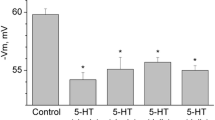Abstract
The effects of serotonin on the amplitude of summated EPSP in interneurons and on the duration of action potentials in sensory neurons, interneurons, and motoneurons involved in avoidance behavior were investigated in functionally distinct neurons isolated from theHelix pomatia nervous system. The duration of action potentials in sensory neurons was found to increase under the effects of serotonin (and this could underly the rise in EPSP amplitude), although that of interneuron and motoneuron spikes did not change. The functional significance of selective neuronal response to a rise in serotonin concentration is discussed, together with the mechanics underlying such effects.
Similar content being viewed by others
Literature cited
N. R. Akopyan, V. I. Il'in, and N. K. Chemeris, "Dopamine-modulated Ca components of action potential in the soma of mullusk (L. stagnalis) neurons," Biofizika,29, No. 2, 284–288 (1984).
P. M. Balaban, Habituation and sensitization in command neurons involved in theHelix pomatia avoidance reflex," Zh. Vyssh. Nervn. Deyat.,28, No. 2, 356–363 (1978).
P. M. Balaban, O. A. Maksimova, M. V. Shistyakova, and I. S. Zakharov, "Role of serotonin in shaping food avoidance reflex in the snail," Neirofiziologiya,18, No. 3, 291–298 (1986).
T. L. D'yakonova, "Serotonin-regulated plastic properties of electrically excitable membranes," Zh. Vyssh. Nervn. Deyat,35, No. 4, 753–757 (1985).
N. I. Kononenko and A. D. Shcherbatko, "Effects of synaptic activation and serotonin application on neuronal calcium current," Neirofiziologiya,18, No. 1, 77–85 (1986).
P. G. Kostyuk, Calcium and Cell Excitability [in Russian], Nauka, Moscow (1986).
D. B. Logunov, "Homosynaptic post-tetanic potentiation of identified synapses in theHelix pomatia CNS," Dokl. Akad. Nauk. SSSR,274, No. 2, 475–478 (1984).
O. A. Maximova and P. M. Balaban, Neuronal Mechanism of Plastic Behavior [in Russian], Nauka, Moscow (1983).
D. A. Sakharov, O. N. Korobtsev, E. A. Liberman, et al., "Serotonin-sensitive neuronal membrane in the snail," in: Comparative Pharmacology of Synaptic Receptors [in Russian], Nauka, Leningrad (1970), pp. 160–166.
V. M. Storozhuk and I. N. Antonov, "Role of the humoral factor and postsynaptic sensitization in heterosynaptic facilitation," Neirofiziologiya,18, No. 2, 250–259 (1986).
M. Armando-Hardy, J. C. Ellery, H. G. Ferreria, et al., "Inhibition of the calcium-induced increase in the potassium permeability of human red blood cells by quinine," J. Physiol.,250, No. 1, 32P (1975).
P. M. Balaban, "Postsynaptic mechanism of withdrawal reflex sensitization in the snail," J. Neurobiol.,14, No. 5, 365–375 (1983).
C. J. Coates and A. G. M. Bulloch, "Synaptic plasticity in the molluscan peripheral nervous system: physiology and role for peptides," J. Neurosci.,5, No. 10, 2667–2684.
H. M. Gerschenfeld and D. Paupardin-Tritsch, "Ionic mechanisms and receptor properties underlying the responses of molluscan neurones to 5-hydroxytryptamine," J. Physiol.,243, No. 3, 427–456 (1974).
R. D. Hawkins, T. W. Abrams, T. J. Carew, and E. R. Kandel, "A cellular mechanism of classical conditioning inAplysia: activity-dependent amplification of presynaptic facilitation," Science,219, No. 4583, 400–405 (1983).
M. Klein, J. Camardo, and E. R. Kandel, "Serotonin modulates a specific potassium current in the sensory neurons that show presynaptic facilitation," Proc. Natl. Acad. Sci. USA,79, No. 10, 5713–5717 (1982).
K. A. Occor, E. T. Walters, and J. H. Byrne, "Associative conditioning analog selectively increases cAMP levels of tail sensory neurons inAplysia," Proc. Natl. Acad. Sci. USA,82, No. 5, 2548–2552 (1985).
T. C. Pellmar and D. O. Carpenter, "Serotonin induces a voltage-sensitive calcium current in neurons ofAplysia californica," J. Neurophysiol.,44, No. 3, 423–439 (1980).
G. M. Piskunova, N. K. Chemeris, and O. P. Yurchenko, "Effect of serotonin on isolated and dialysed nerve cells of gastropod mollusca," In: Neurotransmitters. Comparative Aspects (J. Salanki and T. M. Turpaev, eds.), Akademiai Kiado, Budapest (1980), pp. 223–233.
H. Shimahara and L. Tauc, "Cyclic AMP induced by serotonin modulates the ability of an identified synapse inAplysia by facilitating the active permeability to calcium," Brain Res.,127, No. 1, 168–172 (1977).
S. H. Thompson and B. W. Aldrich, "Membrane potassium channels," In: The Cell Surface and Neuronal Function (C. W. Cotman et al., eds.), Elsevier, Amsterdam (1980), pp. 49–85.
Additional information
Institute of Higher Nervous Activity and Neurophysiology, Academy of Sciences of the USSR, Moscow. Translated from Neirofiziologiya, Vol. 19, No. 3, pp. 316–322, May–June, 1987.
Rights and permissions
About this article
Cite this article
Balaban, P.M. Serotonin-induced changes in the action of functionally distinct neurons in Helix pomatia. Neurophysiology 19, 230–235 (1987). https://doi.org/10.1007/BF01056621
Received:
Issue Date:
DOI: https://doi.org/10.1007/BF01056621




